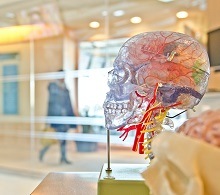 Among people who received endovascular mechanical thrombectomy to remove a large vessel occlusion (LVO), those with a rare genetic disease variant found primarily in people of East Asian descent were more likely to have the vessel reclog during, or shortly after, the procedure. This is according to a study published in the open access journal Stroke: Vascular and Interventional Neurology.
Among people who received endovascular mechanical thrombectomy to remove a large vessel occlusion (LVO), those with a rare genetic disease variant found primarily in people of East Asian descent were more likely to have the vessel reclog during, or shortly after, the procedure. This is according to a study published in the open access journal Stroke: Vascular and Interventional Neurology.
“In the field of acute stroke, genetic testing has not been considered important. However, since our study found that a specific genetic variant substantially affects the outcome of endovascular therapy [EVT], physicians involved in acute stroke medicine, especially in East Asian countries and in western countries where many East Asian descendants are living, need to know these findings,” said senior study author Masafumi Ihara (National Cerebral and Cardiovascular Center, Osaka, Japan).
The genetic variant studied, called RNF213 p.R4810K, is present in one in 50 people of East Asian descent, and in 80–90% of people with the genetic disorder moyamoya disease. Moyamoya is a rare, progressive disorder caused by blocked arteries at the base of the brain that can result in a stroke or other neurological symptoms, such as motor or sensory impairment, headache or vertigo. Because moyamoya is diagnosed by conventional brain angiography or magnetic resonance angiography (MRA), and symptoms are varied and stroke-related, many people may not know they have the disease before experiencing a stroke—as per an American Heart Association (AHA) press release.
Researchers analysed the outcomes of 277 East Asian adults (46.2% women, median age of 76 years) who received EVT for an ischaemic stroke at the National Cerebral and Cardiovascular Center between 2011 and 2021. All of the patients had an acute anterior-circulation LVO—a stroke in which a clot blocks one of the large arteries responsible for supplying blood to the forebrain. The type of endovascular procedure performed was determined by the medical team and was unrelated to whether the patient had the aforementioned genetic variant.
The researchers compared 10 patients found to carry the RNF213 p.R4810K variant to 267 patients without the variant on several short-term outcome measures. Their results were adjusted for the age of the patients.
While people with the genetic variant were just as likely as non-carriers to initially have success with re-establishing blood flow to at least half of the brain tissue that had been deprived of blood during the stroke, study outcomes also revealed that those with the genetic variant were far more likely (70%) than non-carriers (5.6%) to have the treated artery become re-blocked before the procedure was complete, known as ‘instant reocclusion’. Carries of the variant were also far more likely (60%) than non-carriers (0.4%) to have the treated artery become re-blocked within two weeks of an initially successful endovascular procedure, referred to as ‘early reocclusion’.
“We did not imagine this genotype would affect the outcome of endovascular therapy so substantially,” Ihara said. “Information on the genotype will be useful for people who receive endovascular therapy (hopefully before the procedure) because individuals who are of East Asian descent and have the genetic variant need to be more strictly monitored than usual for reocclusion during and after endovascular treatment.”
The number of people found to have the genetic variant was too small to determine which clot-removal devices or medicines may be better at preventing reocclusion—but the researchers are now initiating a larger multicentre study to answer these questions, and to examine the long-term outcome of variant carriers following EVT. “It is important to note, however, that genotyping is currently only available in a research setting, for participants in a clinical trial such as ours,” Ihara added.
According to the researchers, results from this study involving an East Asian population may not be generalised to other people with different genetic backgrounds. “However, additional genetic variants may affect the outcome of endovascular therapy in different ethnic populations, which needs further investigation,” Ihara said.













